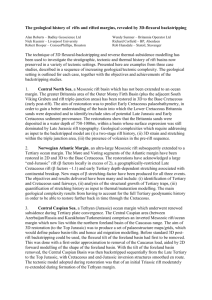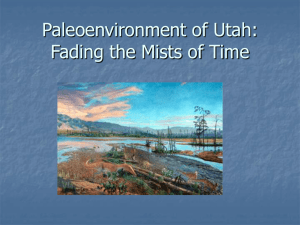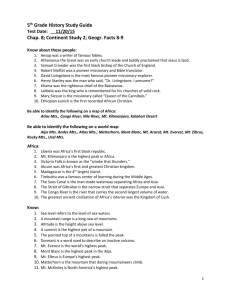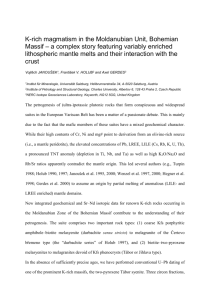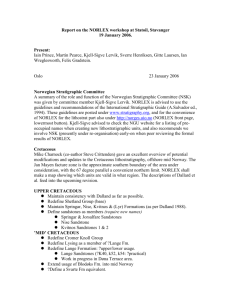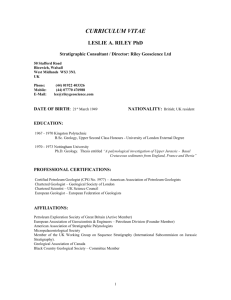Upper Cretaceous tectonic inversion – principle
advertisement
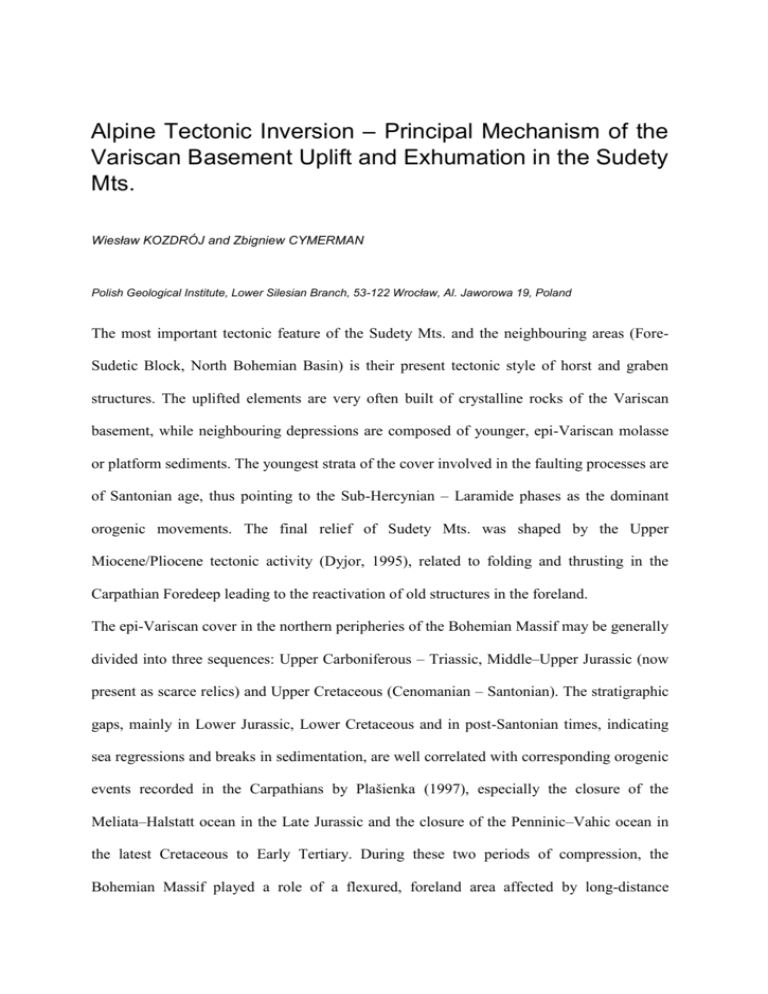
Alpine Tectonic Inversion – Principal Mechanism of the Variscan Basement Uplift and Exhumation in the Sudety Mts. Wiesław KOZDRÓJ and Zbigniew CYMERMAN Polish Geological Institute, Lower Silesian Branch, 53-122 Wrocław, Al. Jaworowa 19, Poland The most important tectonic feature of the Sudety Mts. and the neighbouring areas (ForeSudetic Block, North Bohemian Basin) is their present tectonic style of horst and graben structures. The uplifted elements are very often built of crystalline rocks of the Variscan basement, while neighbouring depressions are composed of younger, epi-Variscan molasse or platform sediments. The youngest strata of the cover involved in the faulting processes are of Santonian age, thus pointing to the Sub-Hercynian – Laramide phases as the dominant orogenic movements. The final relief of Sudety Mts. was shaped by the Upper Miocene/Pliocene tectonic activity (Dyjor, 1995), related to folding and thrusting in the Carpathian Foredeep leading to the reactivation of old structures in the foreland. The epi-Variscan cover in the northern peripheries of the Bohemian Massif may be generally divided into three sequences: Upper Carboniferous – Triassic, Middle–Upper Jurassic (now present as scarce relics) and Upper Cretaceous (Cenomanian – Santonian). The stratigraphic gaps, mainly in Lower Jurassic, Lower Cretaceous and in post-Santonian times, indicating sea regressions and breaks in sedimentation, are well correlated with corresponding orogenic events recorded in the Carpathians by Plašienka (1997), especially the closure of the Meliata–Halstatt ocean in the Late Jurassic and the closure of the Penninic–Vahic ocean in the latest Cretaceous to Early Tertiary. During these two periods of compression, the Bohemian Massif played a role of a flexured, foreland area affected by long-distance horizontal stresses (Ziegler et al., 1995) which were also transmitted to the north as far as the Polish Trough (Krzywiec, 2000). Thus, the Bohemian Massif may be considered as a rigid, forebulge segment in front of the northward propagating Alpine orogeny. The above mentioned horizontal stresses in the Late Palaeozoic – Mesozoic cover produced several folds trending NW–SE to WNW–ESE, well visible in the North Sudetic Basin and the Intra-Sudetic Basin. Intensive fracturing led to the formation of prominent fault lines (many of them inherited after late- and post-Variscan extension) along which some basement blocks were squeezed, uplifted and then affected by erosion. The most spectacular proof of the shortening are inverse faults and even gently dipping thrusts (such as the Lusatian Thrust, Hronov–Poříčí T., border faults of the Nysa Garben (i.e., Zieleniec T., Młoty T., Krosnowice T.), Struga T., Wierzchosławice T., Jerzmanowice T., faults at the SW margin of the Sowie Mts. block, faults bounding the Czerwieńczyce Graben and others). Some of the horsts originated this way may be described as a “pop-up structures”. Displacements of the hangingwalls on the thrust planes have not been sufficiently estimated yet. Geophysical investigations suggest that dip-slip displacement magnitudes may have reached a few hundred meters but the total displacement magnitude may be greater as observed on subhorizontal slickensides suggesting a strong strike-slip component during tectonic transport. Linking the origin of the compressional and strike-slip related structures with synchronously developed, NE–SW-trending extensional rift zones associated with Neogene volcanics (like the Ohře Rift), Cymerman (1999) postulated left-lateral Alpine transpression for the Sudety Mts. While the Lower Cretaceous stage of regional uplift is difficult to assess due to nearly complete removal of the Jurassic strata, the total post-Santonian vertical movements may be well defined by taking the transgressive Cenomanian sediments as a reference horizon (Don, 1996). By comparing its deepest position in the North Bohemian Basin (c. 600 m b.s.l, Malkovský, 1987) and in the North Sudetic Basin (c. 800 m b.s.l., Wykroty N 14 borehole, Bossowski, 1991) with the highly positioned outcrops in the Orlickie and Bystrzyckie Mts. (c. 800 m a.s.l.), a given total vertical difference is greater than 1600 m. There is a close relationship between Alpine, deep-seated faults and thrusts and the distribution of mineral and thermal waters in the Sudetes. A further detailed recognition of the present crustal activity within the fault network is also important for the identification of geohazards (seismicity) and location of hydrographic constructions. References BOSSOWSKI A. (Ed.), 1991. Profile głębokich otworów wiertniczych Państwowego Instytutu Geologicznego, Zeszyt 72, Wykroty N-14. Państwowy Instytut Geologiczny. Warszawa. CYMERMAN Z., 1999. Alpejska transpresja w Sudetach. Przeg. Geol., 47, 10: 942-945. DON J., 1996. The Late Cretaceous Nysa Graben: implications for Mesozoic–Cenozoic fault-block tectonics of the Sudetes. Z. geol. Wiss., 24, 3/4: 317-424. DYJOR S., 1995. Young Quaternary and recent crustal movements in Lower Silesia, SW Poland. Folia Quarternaria, 66: 51-58. KRZYWIEC P., 2000. O mechanizmach inwersji bruzdy środkowopolskiej – wyniki interpretacji danych sejsmicznych. Biuletyn PIG, 393: 135-166. MALKOVSKÝ M., 1987. The Mesozoic and Tertiary basins of the Bohemian Massif and their evolution. Tectonophysics, 137: 31-42. PLAŠIENKA D., 1997. Cretaceous tectonochronology of the central Western Carpathians, Slovakia. Geologica Carpathica, 48, 2: 99-111. ZIEGLER P.A., CLOETINGH S., VAN WEES J.-D., 1995. Dynamics of intra-plate compressional deformations: the Alpine foreland and other examples. Tectonophysics, 252: 7-59.
